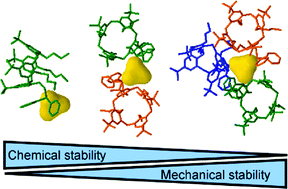The synthesis and characterization of new cluster compounds represented by the series Ir4(CO)12−xLx (L = tert-butyl-calix[4]-arene(OPr)3(OCH2PPh2); x = 2 and 3) is reported using ESI mass spectrometry, NMR spectroscopy, IR spectroscopy and single-crystal X-ray diffraction. Thermally driven decarbonylation of the cluster compound series represented by x = 1–3 according to the formula above is followed viaFTIR and NMR spectroscopies, and dynamic light scattering in toluene solution. The propensity of these clusters to decarbonylate in solution is shown to be directly correlated with number density of adsorbed calixarene phosphine ligands and controlled via Pauli repulsion between metal d and CO 5σ orbitals. The tendency for cluster aggregation unintuitively follows a trend that is exactly opposite to the cluster's propensity to decarbonylate. No cluster aggregation is observed for clusters consisting of x = 3, even after extensive decarbonylationvia loss of all bridging CO ligands and coordinative unsaturation. Some of the CO lost during thermal treatment viadecarbonylation can be rebound to the coordinatively unsaturated cluster consisting of x = 3. In contrast, the clusters consisting of x = 1 and x = 2 both aggregate into large nanoparticles when treated under identical conditions. Clusters in which the calixarene phosphine ligand is replaced with a sterically less demanding PPh2Me ligand 6 lead to significantly less coordinative unsaturation upon thermal treatment. Altogether, these data support a mechanical model of accessibility in coordinatively unsaturated metal clusters in solution, which hinges on having at least three sterically bulky organic ligands per Ir4 core.

You have access to this article
 Please wait while we load your content...
Something went wrong. Try again?
Please wait while we load your content...
Something went wrong. Try again?


 Please wait while we load your content...
Please wait while we load your content...